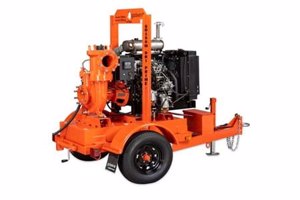
ABOUT XYLEM RENTAL SOLUTIONS
Xylem (XYL) is a leading global water technology company committed to solving critical water and infrastructure challenges with innovation. Our more than 16,000 diverse employees delivered revenue of $4.88 billion in 2020. We are creating a more sustainable world by enabling our customers to optimize water and resource management, and helping communities in more than 150 countries become water-secure. Join us at www.xylem.com.
FEATURED ARTICLES
-
Xylem Rental Solutions engineered an affordable and functional temporary bypass system to keep water out of a sedimentation basin so crews could erect a weir to reduce the potential for carbon discharge into the Niagara River.
-
There’s no good time to interrupt production at a manufacturing facility. For a worldwide leader in audio equipment, halting production for a facility maintenance project leading up to the busy holiday season was not an option.
-
The Flygt 4220 Compact Adaptive Mixer rental unit provides effective wastewater mixing for a wide range of water utility applications.
-
The City of Albion, Michigan completed the update of several components of its four-MGD plant in the fall 2017. Afterwards, plant superintendent Kent Phillips became interested in testing the impact that optimizing his mixing might have on other aspects of his conventional activated sludge process with enhanced biological phosphorus removal.
-
When the West Side sewage pump station in Onondaga County, New York, prepared to undergo its first major upgrade in over 30 years, the project required a bypass system to move a peak flow of 30 million gallons per day (MGD). C.O. Falter Construction was named the bypass contractor for the project and worked with Xylem to design and install a temporary system to convey the full amount of flow.
-
Godwin’s Dri-Prime 16-in. pump ran a sewer bypass system continuously for a month without issues while the city of Raleigh, North Carolina, replaced a major outfall line feeding its wastewater treatment plant. The Dri-Prime NC350 combined Flygt N-technology with its innovative self-cleaning impeller and Godwin Field Smart Technology, which provides 24/7 remote monitoring of the pump.
-
The town of Greenwich, Connecticut’s existing 54-in. diameter concrete sanitary sewer line, which carried nearly all of the town’s wastewater flow, was being attacked by hydrogen sulfide and deteriorating. After a condition assessment, it was determined that this critical infrastructure should be rehabilitated as soon as possible. In order to complete the sanitary sewer rehabilitation while maintaining treatment operations, a 40.9 million gallons-per-day temporary bypass system was needed to divert the flow from three areas of town to the wastewater treatment plant.
-
New York’s Albany County was in the process of updating its wastewater treatment plants when it turned to BCI Construction for a temporary bypass system to transfer 88 million gallons per day during the project. The county wanted to avoid interruption of sewer service and needed a solution that would allow it to continue replacing its old chlorine bleaching tanks with UV technology.
-
In Colorado, the project team for an expansion and renovation of a wastewater treatment plant was in need of a bypass system to move a peak flow of 128 million gallons per day. Wagner Rents, the rental arm of Wagner Equipment and Xylem’s Godwin and Flygt distributor in Colorado was named the bypass contractor for this portion of the job. Wagner Rents pump team worked with Xylem to design and install a temporary system to convey the full amount of flow. The solution that followed also provided the treatment plant with the ability to integrate the temporary bypass into its SCADA system and to log the data as if it was its own permanent pumping system.
-
The devastating impact of Hurricane Sandy on New York City and the Northeast U.S. surprised some, but the people at Xylem were not among them. Xylem’s dedicated water professionals stood ready to fight the surging seawaters and torrential rainfall that threatened thousands of homes and commercial properties in Sandy’s path.
-
Mayfield Creek in Fulton County, New York, is an arterial body that flows out of Great Sacandaga Lake for approximately four miles through farmland and the upstate countryside. At several points along the way, the creek runs through culverts and under bridge structures, as highways and local roads intersect its path. During an inspection, it became clear that one major culvert – 140 feet long, 15 feet tall and running under heavily traveled Route 30 – had outlived its expected life. The 10-guage corrugated steel structure was deteriorated and needed to be repaired – with as little disruption to Route 30 traffic patterns as possible.
-
Record rainfalls in Memphis, TN eroded the soil supporting a 96-inch sanitary sewer main, causing the line to fail. With nearly 40 million gallons per day (MGD) of raw sewage escaping into Cypress Creek, less than a mile from McKellar Lake and the Mississippi River, an emergency bypass was needed fast to facilitate the repair work on the 96” sewer main. City officials immediately activated their Emergency Response Plan, gathering the management team from the Public Works Division and bringing in the experts at Xylem, to help assess
the damage and to map out an action plan. -
When operators at the Rivanna Water & Sewer Authority (RWSA) in Charlottesville, Virginia discovered a compromise in the 54- inch secondary effluent water line at their Moores Creek Advanced Water Resource Recovery Facility, they took immediate action to address the problem. The obvious solution was an emergency bypass, but the facility needed a temporary system that wouldn’t harm the creek or shut down the critical access bridge crossing it.
-
Canada’s Region of Peel is a permanent home to more than 1 million people and a temporary stopover for another 20 million air travelers who pass through Toronto Pearson Airport each year. Those numbers add up to make Peel Region the second largest province in Ontario, and Toronto Pearson the busiest airport in all of Canada. They also added a high level of complexity to a recent wastewater construction project, which Atlas and Xylem teams solved with an equally intricate bypass solution.
-
The first sign of trouble in “America’s Hometown” came on December 19, 2015. Plymouth, Massachusetts is the celebrated site where the Pilgrims landed in 1620, but on this day the prominent municipality was facing a major problem: the 4.5-mile force main from the Water Street Pump Station to the Plymouth Wastewater Treatment Plant (WWTP) had given way. “This was a critical emergency,” says Joe Brito, Jr., President of C. Brito Construction Co., Inc. “so we needed to bring in a team that could get it done, and do it right the first time. We called Tom Malone immediately, the New England branch manager at Xylem, who had delivered for us previously. We knew we were in good hands.”
-
The city of Atlanta faced a critical problem in 2013 when the city’s Nancy Creek Tunnel failed due to years of sediment buildup. The tunnel is an 8-mile-long system that runs under northwest Atlanta, built to increase sewer capacity and handle storm water during heavy rains. The tunnel ends at the Nancy Creek Tunnel Lift Station, which pumps the wastewater to the treatment plant above it. With heavy rains on the way at the time, the city faced potential violations and large fines from the U.S. Environmental Protection Agency if the tunnel could not handle the extra flow.
-
To stay in compliance with state Environmental Protection Agency requirements, the Kiski Valley Water Pollution Control Authority (KVWPCA) in Pennsylvania had to double the capacity of one of its plants – from 15 million gallons per day (MGD) facility to 31 MGD. The large-scale job called for outside expertise and innovative solutions.
-
True leaders recognize problems before they become emergencies. A case in point is the Wastewater Department team in Tampa, Florida. As part of the city’s proactive maintenance program, they determined that the Krause Pump Station – which was almost 40 years old – had exceeded its designed life expectancy and was in need of rehab. Before the aging station could break down, the Tampa team reached out to local contractor Vogel Brothers Building Company and the pump experts at Xylem to assess the project, design a robust bypass plan and implement the bypass while the station was being rebuilt.
-
The Cape Fear Public Utility Authority (CFPUA) in North Carolina engaged in a capital improvement project to help address their aging infrastructure. The project was identified as the Northeast Interceptor Rehabilitation Phase 2 Project (NEI Rehab), which included the replacement of the ductile iron pipe (DIP) force main – susceptible to sanitary sewer overflows – between the Bradley Creek and Hewlett’s Creek Pump Stations.
-
During any given year, average rainfall in the Victor Valley of Southern California is approximately five inches. But 2010 wasn’t the average year. Five storms in December 2010 dropped one year’s worth of rain – more than five inches – in just one week, unleashing a chain of events that overwhelmed systems and wreaked havoc throughout the area.
-
Sanitation District No. 1 of Northern Kentucky (SD1) needed to perform wet well concrete rehabilitation to two pump stations in Covington, Kentucky, located just across the Ohio River from Cincinnati. The Eighth Street pump station is designed to pump up to 26.3 million gallons per day (MGD) under normal conditions and 28.5 MGD during flood events, while the Patton Street pump station is designed to pump up to 12.8 MGD under normal conditions and 20.1 MGD during flood events.
-
Greenwich, Connecticut, located in the tristate area immediately surrounding New York City, is a scenic New England town that is home to approximately 60,000 people. It was first settled in 1640 on a spot between the Asamuck and Patomuck Rivers, and like many historic towns, Greenwich proactively addresses aging infrastructure on a continuing basis. Its ongoing initiatives include repairs and upgrades to the town’s wastewater treatment plant and 28 pumping stations.
-
After a sewage pump failure at the Menlo Lift Station left the station without a back-up pump, they immediately needed a replacement pump that could handle flow rates of 378 gallons per minute.
-
Lancaster, Pennsylvania, like hundreds of other cities across the nation, is tackling the challenges of upgrading its water and sewage system as efficiently and cost-effectively as possible. A key part of the city’s endeavor is the upgrade of four pumping stations along the Conestoga River to reroute more stormwater to the City’s Advanced Wastewater Treatment Plant (AWWTP), versus draining it into the river.
-
The Owasco Outlet in Auburn, New York, is a waterway that flows from the north end of Owasco Lake through five counties before connecting to the Seneca River. Over time, portions of the Owasco Outlet were contaminated with coal tar. A byproduct of burning coal, the coal tar had been buried throughout the grounds of a former manufactured gas plant located along the waterway during the 1800s, eventually leaching into the surrounding sediment.
-
There is never a good time for a municipality to encounter problems with its water supply. But during the 2020 COVID-19 outbreak – when handwashing and sanitation are essential to maintaining public health – a reduction in water supply to residents quickly becomes critical.
-
Electric submersible pump is another game-changing rental solution
-
Lift stations are an essential component of many municipal and industrial wastewater collection systems to move sewage from low to high elevation. Such is the case for the John Street lift station in Monroe County, New York, which serves both a large residential community and the nearby campus of Rochester Institute of Technology (RIT).
-
Not addressing suction cavitation can wreak havoc on a pump, damaging both the impeller and front wear plate. The result is compromised pump efficiency and productivity, not to mention downtime and some potential ugly repair bills. Download our paper now and learn how suction cavitation occurs and how you can remedy it.
-
For decades, the standard in temporary bypass pumping has been diesel-powered portable pumps, and for good reason: Their flexibility and the ability to set them up anywhere has made them the go-to choice. But with fluctuating fuel and rising servicing costs, as well as growing interest in cleaner, greener sources of power, electric-drive pumps can be a viable alternative for project needs, especially for longer-term projects.
CONTACT INFORMATION
Xylem Rental Solutions
1 International Drive
Rye Brooke, NY 10573
UNITED STATES
Phone: 224-500-0742
Contact: Amanda Holloway




































